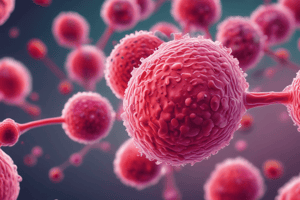Podcast
Questions and Answers
What is the primary causative agent of Gonorrhea?
What is the primary causative agent of Gonorrhea?
- Trichomonas vaginalis
- Chlamydia trachomatis
- Treponema pallidum
- Neisseria gonorrhoeae (correct)
Which of the following is a common subjective presentation of Chlamydia?
Which of the following is a common subjective presentation of Chlamydia?
- Frothy, greenish-yellow vaginal discharge
- Painless chancre
- Increased penile discharge
- Abnormal vaginal discharge and dysuria (correct)
What management is recommended for Trichomonas infection?
What management is recommended for Trichomonas infection?
- Dual antibiotic therapy with ceftriaxone and azithromycin
- Azithromycin for 3 days
- Single dose of Metronidazole (correct)
- Doxycycline therapy for 7 days
Which sign is characteristic of primary Syphilis?
Which sign is characteristic of primary Syphilis?
What is a recommended follow-up plan for patients treated for Gonorrhea?
What is a recommended follow-up plan for patients treated for Gonorrhea?
What is the main function of non-treponemal tests in syphilis diagnosis?
What is the main function of non-treponemal tests in syphilis diagnosis?
Which of the following statements about treponemal tests is correct?
Which of the following statements about treponemal tests is correct?
What is the first-line treatment for primary or secondary syphilis in non-allergic patients?
What is the first-line treatment for primary or secondary syphilis in non-allergic patients?
Which of the following statements regarding genital warts is true?
Which of the following statements regarding genital warts is true?
What is a potential risk associated with treatment for syphilis?
What is a potential risk associated with treatment for syphilis?
Flashcards are hidden until you start studying
Study Notes
Gonorrhea
- Caused by Neisseria gonorrhoeae, a gram-negative bacterium.
- Risk factors include multiple sexual partners, unprotected sex, and previous STIs.
- Often asymptomatic, but can present with dysuria, increased vaginal or penile discharge, and pelvic pain.
- Diagnostic workup includes NAAT from urine or swabs (vaginal, cervical, urethral).
- Manage with dual antibiotic therapy: ceftriaxone IM and oral azithromycin.
- Emphasize partner notification, condom use, and abstinence until cleared.
- Retest in 3 months due to high reinfection rates.
Chlamydia
- Caused by Chlamydia trachomatis, can lead to pelvic inflammatory disease (PID) if untreated.
- Risk factors consist of unprotected sex and multiple sexual partners.
- Subjective presentations often include abnormal vaginal discharge and dysuria; asymptomatic cases are common.
- Focused physical exam may reveal cervical motion tenderness (CMT) and abnormal discharge.
- Diagnostic method includes NAAT from vaginal or urethral swabs.
- Treat with antibiotics such as azithromycin or doxycycline; ensure treatment of sexual partners.
- Follow-up includes retesting in 3 months.
Trichomonas
- Caused by the parasite Trichomonas vaginalis.
- Risk factors mainly involve unprotected sex.
- Symptoms include frothy, greenish-yellow vaginal discharge, pruritus, and dysuria; may show "strawberry cervix."
- Objective examination may find motile protozoa.
- Management involves a single dose of metronidazole; partners should also be treated.
Syphilis
- Caused by Treponema pallidum; high-risk groups include those with multiple partners, MSM, HIV-positive individuals, and substance users.
- Primary Stage: Painless chancre; may resolve spontaneously in 3-6 weeks if untreated.
- Secondary Stage: Fever, malaise, sore throat, skin rash (especially on palms/soles), mucous membrane lesions, patchy alopecia.
- Tertiary Stage: Neurological symptoms, cardiovascular issues, or gummatous lesions.
- Diagnostic testing includes non-treponemal tests (screening) and treponemal tests (confirmatory and specific).
- Treat primary/secondary syphilis with Benzathine penicillin G; alternatives for allergy include doxycycline or tetracycline.
- For early latent syphilis, benzathine penicillin G is administered weekly for 3 weeks.
- Neurosyphilis is treated with intravenous penicillin G.
- Caution about Jarisch-Herxheimer reaction after treatment, usually in early stages.
Genital Warts
- The most common STI globally; caused by specific low-risk types of HPV (6 and 11).
- Hyperplasia of epithelial cells leads to characteristic warty growths.
- Spread through skin-to-skin contact, notably via sexual activities.
- Risk factors include multiple partners, unprotected sex, early sexual debut, smoking, immunosuppression, and previous STIs.
- Often presents as painless, soft growths on the genitals or anus, usually asymptomatic.
- Diagnosis is primarily clinical; further testing is only required for biopsy or concerns about syphilis.
Studying That Suits You
Use AI to generate personalized quizzes and flashcards to suit your learning preferences.




